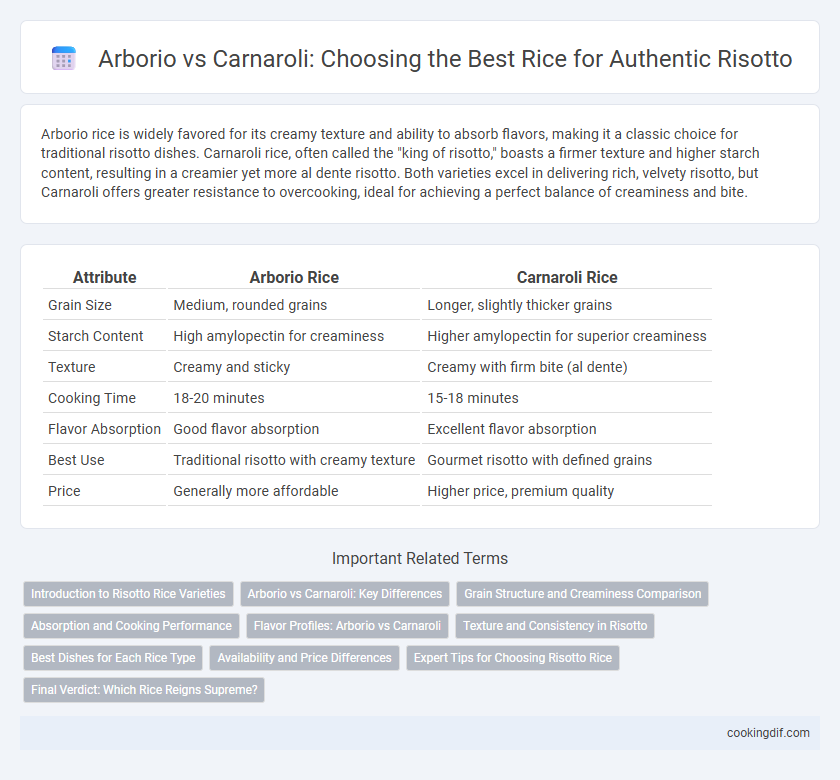Arborio rice is widely favored for its creamy texture and ability to absorb flavors, making it a classic choice for traditional risotto dishes. Carnaroli rice, often called the "king of risotto," boasts a firmer texture and higher starch content, resulting in a creamier yet more al dente risotto. Both varieties excel in delivering rich, velvety risotto, but Carnaroli offers greater resistance to overcooking, ideal for achieving a perfect balance of creaminess and bite.
Table of Comparison
| Attribute | Arborio Rice | Carnaroli Rice |
|---|---|---|
| Grain Size | Medium, rounded grains | Longer, slightly thicker grains |
| Starch Content | High amylopectin for creaminess | Higher amylopectin for superior creaminess |
| Texture | Creamy and sticky | Creamy with firm bite (al dente) |
| Cooking Time | 18-20 minutes | 15-18 minutes |
| Flavor Absorption | Good flavor absorption | Excellent flavor absorption |
| Best Use | Traditional risotto with creamy texture | Gourmet risotto with defined grains |
| Price | Generally more affordable | Higher price, premium quality |
Introduction to Risotto Rice Varieties
Arborio and Carnaroli are two of the most popular risotto rice varieties, each known for their unique starch content and texture. Arborio rice, widely used and readily available, offers a creamy consistency with a slightly firm center, ideal for classic risotto recipes. Carnaroli rice, often called the "caviar of rice," has a higher starch content and firmer grains, providing superior creaminess and resistance to overcooking, preferred by professional chefs for luxurious risottos.
Arborio vs Carnaroli: Key Differences
Arborio rice is characterized by its round, plump grains and higher amylopectin content, which results in a creamy texture but with a tendency to become mushy if overcooked. Carnaroli rice features longer grains and a firmer texture, offering better resistance to overcooking and a slightly chewier bite, making it favored by chefs for risotto requiring perfect al dente consistency. The choice between Arborio and Carnaroli impacts the final dish's texture and creaminess, with Carnaroli often considered the premium option for its balance between creaminess and grain integrity.
Grain Structure and Creaminess Comparison
Arborio rice features shorter, plumper grains with a higher starch content that yield a creamy texture ideal for traditional risotto. Carnaroli grains are longer and firmer, offering better structural integrity during slow cooking, resulting in a creamier, al dente finish that resists overcooking. The choice between Arborio and Carnaroli depends on balancing creaminess with grain firmness, where Carnaroli is often preferred by chefs for superior texture control.
Absorption and Cooking Performance
Arborio rice is known for its high starch content, providing excellent absorption that results in a creamy texture, while Carnaroli offers superior cooking performance due to its firmer grains that hold shape better during prolonged cooking. Carnaroli absorbs liquid more gradually, allowing for greater control and a consistently al dente finish. The balance of starch release and grain integrity makes Carnaroli preferred for professional risotto preparation, though Arborio remains a popular choice in home kitchens for its accessibility and rich creaminess.
Flavor Profiles: Arborio vs Carnaroli
Arborio rice offers a creamy texture with a slightly nutty and robust flavor, making it a popular choice for traditional risotto dishes. Carnaroli rice features a firmer bite and a more delicate, subtly sweet flavor profile that enhances the complexity of sophisticated risotto recipes. The choice between Arborio and Carnaroli depends on whether a richer, heartier taste or a refined, nuanced flavor is desired in the final dish.
Texture and Consistency in Risotto
Arborio rice offers a creamy texture with a slightly firm bite, making it ideal for a classic risotto consistency that holds its shape while providing a smooth mouthfeel. Carnaroli rice has a higher starch content and a firmer grain, resulting in a silkier, creamier texture with enhanced firmness, often preferred by chefs for its superior ability to maintain consistency throughout prolonged cooking. The choice between Arborio and Carnaroli directly affects the final risotto's balance between creaminess and al dente texture.
Best Dishes for Each Rice Type
Arborio rice, known for its creamy texture and ability to absorb flavors, is ideal for traditional risotto dishes like Risotto alla Milanese and mushroom risotto that benefit from a rich, velvety consistency. Carnaroli rice, prized for its larger grains and firmer texture, excels in recipes requiring al dente bite and distinction, such as seafood risotto and saffron-infused risottos. Chefs often prefer Carnaroli for complex risottos needing stability during slow cooking, while Arborio suits quick, delicate preparations.
Availability and Price Differences
Arborio rice is widely available in most supermarkets and tends to be more affordable, making it a popular choice for everyday risotto preparation. Carnaroli rice, often labeled as a premium variety, is less commonly stocked and typically commands a higher price due to its superior starch content and creaminess. The price difference reflects Carnaroli's reputation among chefs for producing a creamier, more al dente texture, while Arborio remains a budget-friendly and accessible option.
Expert Tips for Choosing Risotto Rice
Arborio rice offers a creamy texture with its high starch content, ideal for traditional risottos seeking a smooth consistency. Carnaroli rice, known as the "caviar of risotto rice," boasts a firmer grain and better absorption, allowing for more forgiving cooking and a slightly al dente finish preferred by professional chefs. Experts recommend Carnaroli for advanced risotto techniques due to its superior ability to retain structure and absorb flavors without becoming mushy.
Final Verdict: Which Rice Reigns Supreme?
Carnaroli rice is often hailed as the king of risotto due to its higher starch content, which creates a creamier texture and better firmness during cooking compared to Arborio. Arborio rice remains a popular choice for its accessibility and slightly quicker cooking time, but it tends to release less starch, resulting in a less velvety finish. For chefs seeking the ultimate risotto experience, Carnaroli's superior ability to maintain al dente consistency and rich creaminess solidifies its status as the preferred rice variety.
Arborio vs Carnaroli for risotto rice Infographic

 cookingdif.com
cookingdif.com